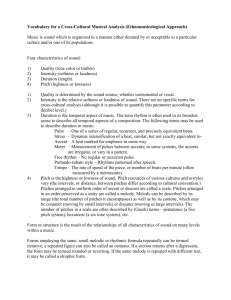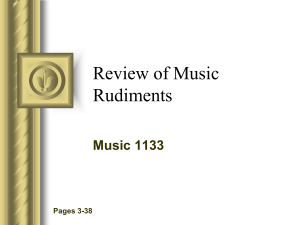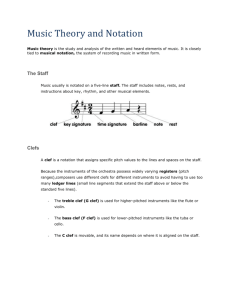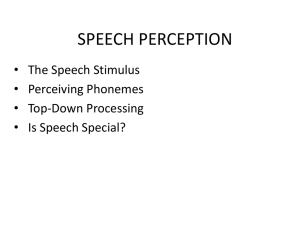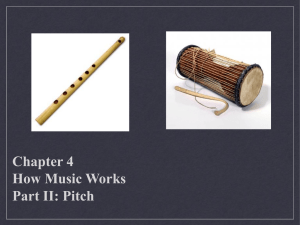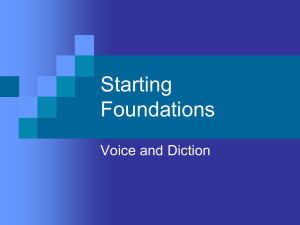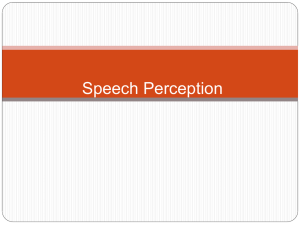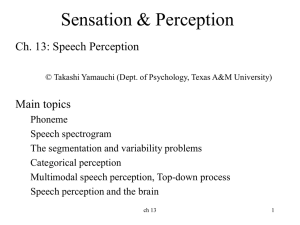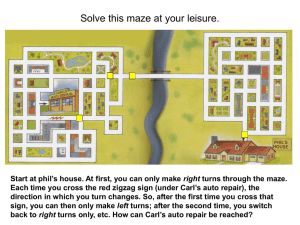Chapter 12: Speech and Music Perception
advertisement
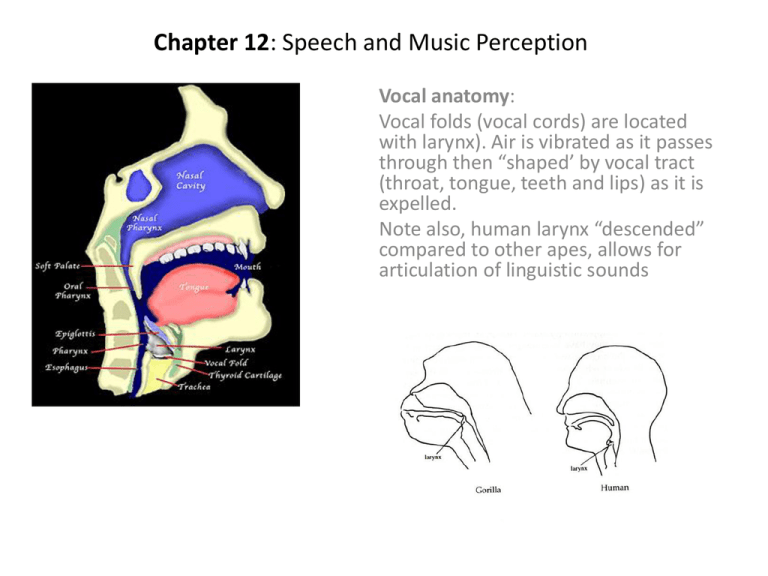
Chapter 12: Speech and Music Perception Vocal anatomy: Vocal folds (vocal cords) are located with larynx). Air is vibrated as it passes through then “shaped’ by vocal tract (throat, tongue, teeth and lips) as it is expelled. Note also, human larynx “descended” compared to other apes, allows for articulation of linguistic sounds Studying the speech signal: Sound spectrograms Visually depicts energy levels at different frequencies for speech sounds. Darker areas indicate greater energy. Note: widespread energy across 15K Hz for “I”; low frequency energy for “miii”, hissing “sss” more widespread energy, then high frequency energy for “y” which then drops to lower “ooouuu” Neurogram: sound spectrogram could also be understood as depicting activity along BM over time moving from base (hi freq) to apex (lo freq). Invariance Problem with phonemic signals Phonemes are basic units of sound in language (/b/; /d/; /ch/ etc). However, their acoustic signal is not invariant, so how do we identify them? To answer first must review brain regions active in speech perception. Brain areas involved in speech processing PAC does not respond preferentially to speech sound, but WA (left hemisphere) does. Damage to WA produce receptive aphasia (inability to understand speech). Damage to BA produces production aphasia, inability to produce speech. Motor areas of brain also activated in speech perception. Analogous structures in RH process emotional content of speech; identify speaker from cadence, intonation patterns, etc.; not so much meaning of speech. Damage to right WA can produce phonagnosia – inability to indentify speaker but still can understand speech. Auditory pathways from PAC Similar to “what” and “where” pathways in visual system, two pathways extend from PAC. Red, ventral pathway deals more with extracting meaning from sounds, including phonemic sounds. Blue, dorsal pathway deals more with processing rhythm and intonation patterns. Note: RH shown in image, similar arrangement also found in LH Back to identifying phonemes How can we identify phonemes if they are not associated with consistent acoustic signal? Two Contextual factors: Motor information: We use motor information (movements of face and mouth, to disambiguate) phoneme -- recall that motor cortex is active in speech perception -- McGurk effect: motor information affects perception Back to identifying phonemes 2nd contextual factor: Semantic context, what makes sense? EX: phonemic restoration effect. If a sound is removed from a sentence, people still claim to have heard a sound consistent with the meaning of the sentence. The *eel was on the axel (wh)/ shoe (h) /orange (p)/ table (m) Music Perception Melody: the central aspect of music. Structured organization of pitches that create an identifiable pattern. Composed of absolute intervals, relative intervals, and pitch contour. Absolute intervals: distance between pitches which in the leftmost example (in Hungarian!) is one whole note Relative intervals: relationship among intervals in a group of notes. In distortion one (middle example) absolute intervals have been doubled (two whole notes now separate each note, but relative intervals remain constant – remains 1:1 across all notes, all notes separated by 2 whole notes). Pitch contour: pattern of rising and falling pitches in a group of notes. In example below pitch contour is always, 1<2<3. Note in distortion 3 (rightmost example), pitch contour is preserved but absolute and relative intervals have been distorted. Results: Most could still indentify melody in distortion one (relative intervals and pitch contour present) and distortion 3 (only pitch contour present). When none present most could not identify melody. Absolute (“perfect”) pitch Ability to correctly identify any note played. Ability seems to be more present in younger aged kids then tends to diminish. One hypo is that it might be detrimental to language development. Language perception requires ignoring “absolute” tonal qualities for relative or contextual ones. Brain areas associated with music perception Areas both anterior and posterior to PAC important for music perception. RH anterior superior temporal sensitive to pitch variation and pitch chroma (similarity between same pitches at different octaves – middle vs. high C). Superior posterior temporal more sensitive to pitch height (difference between high vs. middle C). Left anterior temporal: especially sensitive to rhythmic qualities of melody Factors affecting emotional quality of music Increasing and decreasing tempo and intensity tend to have greatest effects on emotional content. Crosscultural constancy
